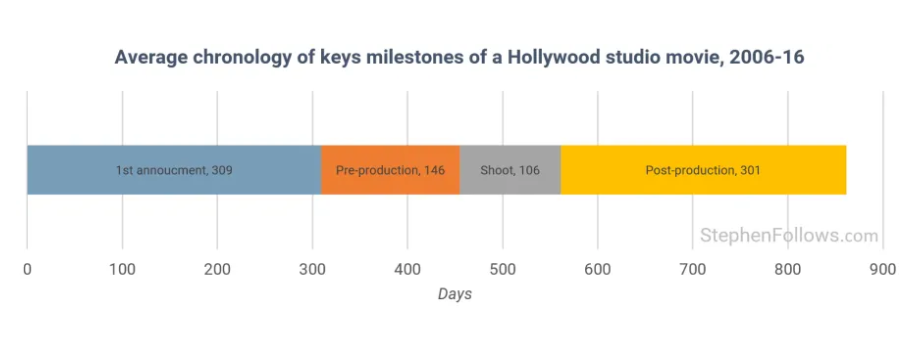Whenever you invest in anything, there’s usually one big question on your mind: “When do I get paid?” An investment in Hollywood is no different. Before you invest, you should understand when you’ll get your money and where it will come from.
But a lot of investors don’t! They have no idea how long it will take. If they knew the truth at the beginning, they probably wouldn’t have invested or they would have taken better steps to protect themselves. In this article, I’m going to lay out when and how you’ll get paid from your film investment.
Whenever you invest in anything, there’s usually one big question on your mind: “When do I get paid?” Share on XThe Hard Truth
Most of the time, investors don’t get paid anything at all. Most independent investments never make a sale. I’m talking about the films made for $5,000 to $5 million dollars. They turn into nothing because the “filmmakers” (I use the term loosely) are inexperienced and untested. In a lot of cases, they make content with elements that are not salable.
A salable element is something that puts asses in theater seats or inspires a VOD purchase. It’s something you can put on a DVD cover. It’s the meat of a pitch to a distributor. People are salable elements, like actors or directors and NEVER a producer or crew. A great piece of written material is salable, too.
As the investor, you should only work with filmmakers who have contractually attached salable elements. Anything else is just a waste of your money. And when I say “contractually attached,” I’m not talking about the bullshit “letter of intent.” You can line the bottom of a bird cage with that kind of agreement and that’s about it! I mean an agreement that commits an actor to a project and a defined set of dates.
How do filmmakers obtain salable elements? By integrating with the filmmaking community, knowing creative people, and building a strong reputation. Mostly, this means knowing agents who are willing to part with their elements.
Agents want to connect filmmakers with actors and writers (that’s their whole damn purpose), but they won’t let their clients sign with just anyone. Bad projects could hurt their careers and make them less valuable.
So agents are only willing to attach their clients to projects if they know the filmmaker, how she works, where he fits into the industry, and how well they perform in their vertical (features, dramatic TV, reality, or whatever). They want to put filmmakers into known categories, but that only happens if filmmakers rub elbows with the industry. (Networking!)
Always remember: Agents exist to represent their clients and themselves (and in some cases that order is reversed). They may say they’re on your side and that they want to make a great film, but ultimately their job is to get their client paid as much as possible so they can a commission and move their client’s career forward and up.
The moral of the story here is that you should look for filmmakers who have great packages of saleable elements because it means experts trust them to make good content. You should run away from filmmakers who can’t find a quality package of saleable elements because it means they aren’t tested.
When Do You Get Paid?
If you invest in a movie that actually sells, you won’t see any significant amount of money for at least 36 months. It’s a long winding path with lots of participants that you don’t have any control over. Sucks, but that’s the game.
Let’s walk through the timeline so you can see why it takes so long.
Prep
This takes at least three weeks, but often as much as 12 for feature films. This can go faster if the filmmaker is making something they know well and do often (like the guys who do multiple Hallmark movies each year, for example). The filmmakers will find locations, break down the script for shooting, open the production office, and begin hiring staff. For illustration, let’s say your film needs 6 weeks of prep.
Principal Photography
This depends on the nature of the film, but the average is 106 days or about 15 weeks. We’re up to 21 weeks, which means you’ve spent half the year just prepping and shooting the movie. BTW: most small films and indies shoot in 15-25 days (so think in terms that are relative to the project you are working on.

Editorial
Editors pull a loose assembly together during production to make sure the director didn’t make a mistake or forget to cover something, but there’s still at least four to eight week period after production for working the final cut, technical editing, post sound and striking a a print, etc. We’re up to 29 weeks.
Don’t rush this process. The longer you spend editing, the better the film will be. You can not do good work quickly in editorial. Do not show a film at a festival unless you have a final cut.
Director’s Time
There’s a DGA rule that says directors get three to four weeks with the film. We’re up to 33 weeks.
Oh, and by the way: Don’t invest in development, otherwise you’ll just extend this timeline. Only invest in the production of content with some distribution attached (whether it’s a theater release, home video, streaming platform, etc.) and some tax incentive built into the financing plan.
Acquisitions
This is when you show your film at festivals (if that’s the route you choose to go) and show the final cut to more distributors (hopefully you have some distribution already, but you need more). You have to convince acquisitions people to buy it and then they have to sell it inside their organizations. This will take six months, so we’re up to 57 weeks or just over a year.
Distributor’s Delay
Once you sell the movie to a distributor, you could spend up to a year waiting for the right window to release it. November through the New Year is for Oscar-bait movies. April through the summer is for blockbusters. Indie movies get released January through March and September to October.
So if you deliver in August, you’ll miss the fall and probably the early year. You’ll have to wait an entire year to exhibit your movie that’s ready to go. Let’s say you planned ahead and finished on time, so it only takes 6 months. We’re up to 1.5 years since you cut that check to the filmmaker.
Distribution
Now that consumers can actually buy your movie, it will distribute for about a year across theaters, OTTs, home video, foreign sales, or wherever else you sold it. Minimum guarantees will start to come in, but they won’t be more than you spent. Distributors know they have all the leverage over filmmakers, so any cash they give you ahead of time is a favor. We’re up to 2.5 years.
Reporting
The distributors won’t report numbers to you for another six months. Why so long? Because they can. They’ll sit on your money or use for other projects until they have to pay you. This is the three year mark.
Payment
How quickly you get paid after the first report depends on the distributor, but you’re looking at another three months at the minimum. You’ll continue to get statements and payments for waterfall income every three or six months.
Who Pays You?
Getting paid means working with two entities. We’ll call them the Investment Company and the Production Company.
The Investment Company is usually an LLC that only exists to hold the PPM, own intellectual property, and fund the Production Company. It licenses the IP via distribution deals. It holds the IP forever or until it chooses to sell the rights to someone else.
The Production Company is the entity that makes the film. It receives money from the Investment Company, hires crew, and creates the content. This company does not own the IP for litigious reasons (you don’t want to lose the IP if the company gets sued for some reason). When the movie is made, this company starts to wind down and is eventually closed.
The Investment Company should produce closed financials every month or quarter for the first five years and updates about the incentives. Once the film is delivered to the distributor, there’s nothing to do and talk about, so it will only produce reports semi-annually or annually. Ideally, you should dissolve this company in five years when you either sell the rights or move them to another holding company.
As the investor, you should have significant control over the Investment Company, but you won’t play a part in the Production Company. If you’re the only investor (which I recommend), you have leverage over the PPM terms. But once you fund the investment, you can’t change the PPM unless all the participants agree (unlikely).
Why is control over the Investment Company important? Because without it, the filmmaker can ignore you. If you don’t have a say in how the IP is sold, the filmmaker could make distribution deals that only benefit him. You want to be in a management role so you can control how money is spent and when participants are paid (including yourself).
Get Some Help
When you invest in a Hollywood film, there are at least three years between the day you write the check and the day you start collecting income. You’ll get a few bucks back from tax incentives and minimum guarantees around the two-year point, but getting paid takes time and vigilance.
If you don’t have experience investing in movies, don’t rely on filmmakers. That person has their own agenda. You should have someone advocating for you to make sure you don’t get screwed. Contact me if you need help.






